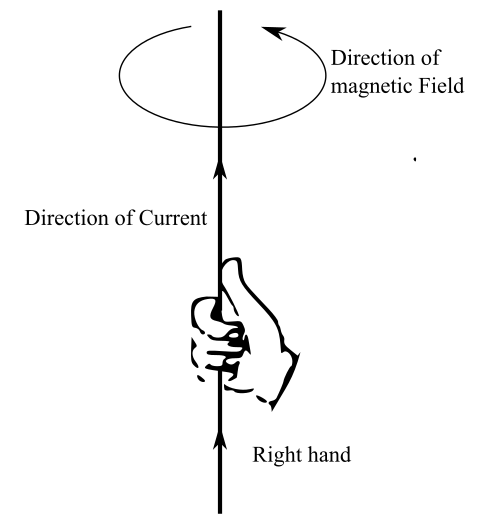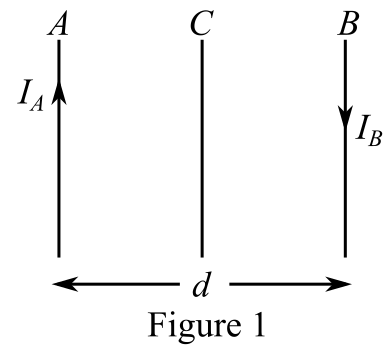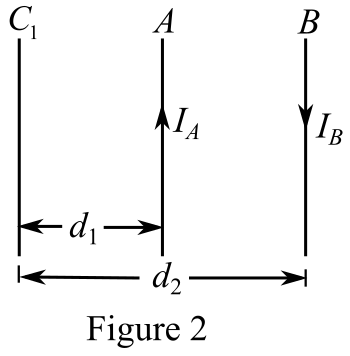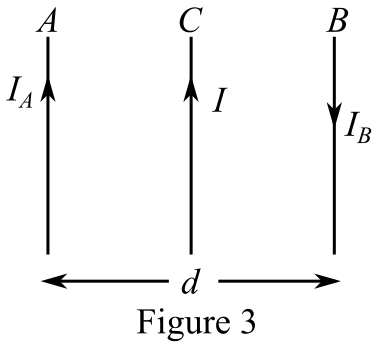
Concept explainers
Two long fixed parallel wires, A and B, are 10 cm apart in air and carry 40 A and 20 A, respectively, in opposite directions. Determine the resultant field (a) on a line midway between the wires and parallel to them and (b) on a line 8.0 cm from wire A and 18 cm from wire B. (c) What is the force per meter on a third long wire, midway between A and B and in their plane, when it carries a current of 5.0 A in the same direction as the current in A?
(a)
The magnetic field at the line midway between the parallel wires
Answer to Problem 25SP
Solution:
Explanation of Solution
Given data:
The distance between the wires
The current flowing in wire
The current flowing in wire
The direction of current in the wires is opposite to each other.
Formula used:
The expression for the magnetic field due to the long straight wire is written as
Here,
The right-hand thumb rule states that if the thumb shows the direction of the current, then the curled fingers show the direction of the magnetic field. Pictorially, this is expressed as

Explanation:
Draw the diagram according to the problem:

Here,
Now, write the expression for magnetic field around wire
Here,
Substitute
Understand that wire
Substitute
The direction of the magnetic field around wire
Write the expression for magnetic field around wire
Here,
Substitute
Understand that wire
Substitute
The direction of the magnetic field around wire
Write the expression for the total magnetic field aroundwire
Substitute
Understand that the direction of the magnetic field at wire
Conclusion:
Hence, the magnetic field around the line midway between the parallel wires
(b)
The magnetic field ona line
Answer to Problem 25SP
Solution:
Explanation of Solution
Given data:
The current flowing in wire
The current flowing in wire
The line is
The line is
The direction of current in the wires is opposite to each other.
Formula used:
The expression for the magnetic field due to the long straight wire is written as
Here,
The right-hand thumb rule states that if the thumb shows the direction of the current, then the curled fingers show the direction of the magnetic field. Pictorially, this is expressed as

Explanation:
Draw the diagram according to the problem:

Here, wire
Now, write the expression for the magnetic field at wire
Substitute
The direction of the magnetic field around wire
Write the expression for the magnetic field around wire
Substitute
The direction of the magnetic field around wire
Write the expression for the total magnetic field aroundwire
Substitute
Understand that the direction of the magnetic field around wire
Conclusion:
Hence, the magnetic field around a line between the wires
(c)
The force per meter on the third wire midway between wires
Answer to Problem 25SP
Solution:
Explanation of Solution
Given data:
The current flowing in wire
The current flowing in wire
The direction of current in the wires is opposite to each other.
The current in third wire is
Formula used:
The expression for the force acting on a wire due to magnetic field is written as
Here,
Explanation:
Draw the diagram according to the problem:

Recall the expression for the force acting on a wire due to magnetic field:
Rearrange the expression for
Recall the value of the calculated magnetic field from subpart (a) and substitute
Using the right-hand rule, wire
Conclusion:
Hence, the force per meter on the third wire midway between wire
Want to see more full solutions like this?
Chapter 31 Solutions
Schaum's Outline of College Physics, Twelfth Edition (Schaum's Outlines)
- If a charged particle moves in a straight line, can you conclude that there is no magnetic field present?arrow_forwardA uniformly charged ring of radius R = 25.0 cm carrying a total charge of 15.0 C is placed at the origin and oriented in the yz plane (Fig. P24.54). A 2.00-g particle with charge q = 1.25 C, initially at the origin, is nudged a small distance x along the x axis and released from rest. The particle is confined to move only in the x direction. a. Show that the particle executes simple harmonic motion about the origin. b. What is the frequency of oscillation for the particle? Figure P24.54arrow_forwardUnder what conditions, if any, will the trajectory of a charged particle not follow a field line?arrow_forward
- A solenoid 10.0 cm in diameter and 75.0 cm long is made from copper wire of diameter 0.100 cm, with very thin insulation. The wire is wound onto a cardboard tube in a single layer, with adjacent turns touching each other. What power must be delivered to the solenoid if it is to produce a field of 8.00 mT at its center?arrow_forwardWire is flowing in a straight wire represented by arrows or a circle symbols, . Using your thumb and curling your fingers, find the direction of the field at the point indicated by the ? . (a) ? \/ (b) > ? (c) o ? (d) x ? (e) ? ^ Group of answer choices a [Choose] b [Choose] c [Choose] d [Choose] e [Choose]arrow_forwardCompute for the magnitude of the line integral over a square path centered on p(0,0) with a side length of 2 for a given field B. B= 3x-hat - y-hatarrow_forward
- A single proton is accelerated in a uniform E-field (directed eastward) at 3.2x10^8 m/s^2. Find the magnitude of the field and direction of the acceleration.arrow_forwardAn electron (charge −e) orbits with speed 2×10^6 [m/s] around a central proton (charge +e, along a circular trajectory with radius 5×10^−11 [m]. If the electron lies on the xy plane, and if the electron moves in a counterclockwise fashion as seen from the top, what is the magnetic field at the location of the proton?arrow_forwardWhat is the magnitude of the total field at the point x = 0, z = 1.00 m in the xz-plane? What is the magnitude of the total field at the point x = 1.00 m, z = 0 in the xz-plane? What is the magnitude of the total field at the point x = 0, z = -0.25 m in the xz-plane?arrow_forward
- A particle of charge Q is fixed at the origin of an xy coordinatesystem. At t = 0 a particle (m = 0.800 g, q = 4.00 mC) is locatedon the x axis at x = 20.0 cm, moving with a speed of 50.0 m/sin the positive y direction. For what value of Q will the moving particleexecute circular motion? (Neglect the gravitational force onthe particle.)arrow_forwardSuppose we have a point particle (P) charge q and velocity v = v(i+j). The point particle is immersed in an electric field E = Ej and magnetic field B = Bj. What is the force experienced by the point particle?arrow_forwardWhy is the following situation impossible? Two identical dust particles of mass 1 μg arefloating in empty space, far from any external sources of large gravitational or electricfields, and at rest with respect to each other. Both particles carry electric charges that areidentical in magnitude and sign. The gravitational and electric forces between the particleshappen to have the same magnitude, so each particle experiences zero net force and thedistance between the particles remains constant.arrow_forward
 Principles of Physics: A Calculus-Based TextPhysicsISBN:9781133104261Author:Raymond A. Serway, John W. JewettPublisher:Cengage Learning
Principles of Physics: A Calculus-Based TextPhysicsISBN:9781133104261Author:Raymond A. Serway, John W. JewettPublisher:Cengage Learning Physics for Scientists and Engineers: Foundations...PhysicsISBN:9781133939146Author:Katz, Debora M.Publisher:Cengage Learning
Physics for Scientists and Engineers: Foundations...PhysicsISBN:9781133939146Author:Katz, Debora M.Publisher:Cengage Learning


